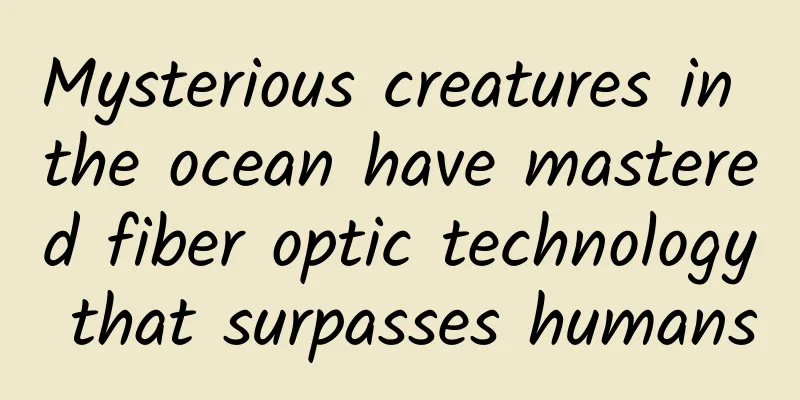Mysterious creatures in the ocean have mastered fiber optic technology that surpasses humans

|
If you dive in the warm Indian-Pacific waters near the equator, you may be lucky enough to find some heart-shaped shellfish in the sand or coral reefs of the shallow sea. They are called heart cockles (Corculum cardissa and spp.) . Their beautiful shells are mainly composed of calcium carbonate , just like the scallops you pick up on the beach, the oysters and clams you eat on the table, and even the stones on the roadside. View image of Some heart cockles (Credit: Dakota McCoy) The shell of the heart cockle has two sides, one always facing the sun and the other always facing the sand, with their soft bodies sandwiched in between. If the side facing the sun gets dirty, the heart cockle will extend its own structure called "foot" from the shell to clean the sand on the shell. These shells may seem simple in structure, but when scientists observe them with high-precision microscopes, they are shocked. Heart cockles always face one side towards the sun and the other side towards the sand (Image source: McCoy et al, 2024) They found that the outer shell of the heart cockle facing the sun is covered with densely packed transparent "small windows" with an average size of less than 1 square millimeter. Under these "small windows" are bundles of tightly packed fiber structures thinner than a hair , which are composed of aragonite, a transparent crystalline form of calcium carbonate. If a beam of light is shot into one end of these fibers, the light will propagate along the fiber and emerge from the other side. Moreover, from one end of these fibers, the image at the other end can be clearly seen, with extremely high resolution: even 100 lines can be distinguished within each millimeter of length. The optical cable structure on the shell of the heart cockle under a scanning electron microscope (Image source: McCoy et al, 2024) This structure feels both strange and familiar to scientists. Strange because they have never found a similar structure in nature before, and familiar because it is very similar to the structure of fiber optic cables that can be seen everywhere in modern human technological civilization. Without optical fiber, there would be no present More than a hundred years ago, the most advanced long-distance information transmission technology was the telephone and telegraph. The information sent by people through the telephone or telegraph would be converted into electrical signals, and then transmitted to another place using copper wires as carriers. However, the amount of information and distance that copper wires can transmit are very limited , and electrical signals are easily weakened and lost, and are also very susceptible to the influence of surrounding electromagnetic fields. Later, people invented optical fiber , which made it possible to transmit electronic information on a larger scale, more stably and over longer distances. Fiber optic image source: BigRiz The core of an optical fiber is usually a long and thin tube made of transparent media such as glass or plastic, which allows light to propagate inside. When a beam of light enters the inside of an optical fiber at a specific angle, it will be constantly reflected on the inner wall and propagate forward along the optical fiber. If we convert the light beam entering the optical fiber into segments of light pulses, we can let them carry binary information (for example, encoding the presence and absence of light as 1 and 0 respectively) and propagate along the optical fiber to a long distance. Light propagates through total internal reflection in an optical fiber (Image credit: Timwether - CC BY-SA 3.0) Putting many optical fibers together makes an optical cable. Compared with cables made of copper wires, optical cables can transmit more information at one time, over a longer distance, and are not easily affected by the outside world . Therefore, optical cables have made the human world more possible. Today, the transmission of the Internet, TV signals, etc. cannot be separated from optical cables. Optical cables connect the information of the human world. Some artificially laid optical cables can even span the entire ocean . Schematic diagram of the structure of an optical cable (Image source: Srleffler (talk) - CC BY-SA 3.0) It can be said that without optical fibers and cables, we might not be able to have an Internet that connects the entire world, and modern human digital civilization might not exist. But such a technology that represents the advanced high-tech civilization of mankind has appeared in the body of a simple mollusk like the heart cockle. Is this an outrageous experiment of a mad scientist, or a remnant of aliens or a mysterious underwater civilization? Installing fiber optic cable for roommate Of course not, this is just a miracle of life. The "optical cables" on the shells of heart cockles are formed by themselves during the evolution process , and the role of these optical cables cannot be underestimated. Like clams, oysters, and mussels, heart cockles are molluscs belonging to the class Bivalvia. Normally, animals need to find their own food to survive. But among bivalves, two groups have independently evolved the ability to coexist with photosynthetic algae . One group is called giant clams (Tridacninae), and the other is heart cockles. The body structure of bivalves (Image source: Scientific American, 1979) Many tiny dinoflagellates live in the mantle, gills and feet of giant clams and heart cockles. Their shells can provide a stable and safe living environment for the dinoflagellates, and the carbon dioxide they produce can also be used as raw materials for photosynthesis by the dinoflagellates. In return, the sugars produced by the dinoflagellates through photosynthesis have also become an important source of nutrition for giant clams and heart cockles. Do you feel something is wrong after reading this? Dinoflagellates need photosynthesis, but they live inside the shells of giant clams and heart cockles. The environment inside must be very dark. Where does the light needed for photosynthesis of dinoflagellates come from? The solution of giant clams is relatively simple and direct. They will open their shells from time to time to expose their soft bodies, so that the dinoflagellates living inside can bathe in sunlight and ensure the photosynthesis. Some giant clam species will even actively extend their mantle out of the shell to get more sunlight. But this will also make the giant clam's soft body lose the protection of its hard shell, and it will be torn or eaten by predators if it is not careful. In contrast, the heart cockle uses a safer and more advanced method - installing optical cables on the shell . Teach humans In a study published in Nature Communications two months ago, researchers used a high-precision laser scanning microscope to observe the shell of the heart cockle. They first discovered that under each "small window" on the shell, there is a small translucent protrusion smaller than sand, and the composition is still aragonite. Computer simulations show that these protrusions act as lenses, which can focus the sunlight entering the "small window" of the shell into a beam and send it to the dinoflagellates in the heart cockle. The role of convex lenses in the symbiosis between heart cockles and dinoflagellates (Image source: McCoy et al, 2024) Later, the researchers switched to a scanning electron microscope to continue observing the fine structure of these "small windows" and were pleasantly surprised to find the "optical cable" structure in them - this is also the first time that an optical cable structure has been found in nature . "Under a microscope, the shells of most heart cockles have a layered structure, with flaky aragonite stacked in different directions, some like fancy brickwork," said Dakota McCoy, the first author of the paper and an assistant professor at the University of Chicago. "However, in the 'small window' area on the shell, the aragonite is arranged in the direction of sunlight, forming dense, hair-thin fibers , rather than a flaky structure." In addition, these optical fibers allow the red and blue light in sunlight - the light most needed for photosynthesis - to enter the heart cockle's interior , while selectively preventing ultraviolet light that can damage DNA from entering. "The optical cables and lenses together form a system that can filter out unsuitable wavelengths of light, but focus the wavelengths of light required for photosynthesis, allowing it to penetrate deep enough into the shell to provide the best possible light environment for the symbiotic dinoflagellates," said Sönke Johnsen, a professor of biology at Duke University and one of the authors of the study. Computer simulations also show that the size, shape and arrangement of these optical cables are the optimal design . Under the same conditions, such a design can send more light into the heart cockle shell. Johnson said that one day, these heart cockles may provide new inspiration for the design of human nano-scale optical cables, creating nano-scale optical cables that can transmit over long distances and are not prone to signal loss. So, is it time for Heart Clam to develop Wi-Fi technology next? References [1]https://www.nature.com/articles/s41467-024-53110-x [2]https://today.duke.edu/2024/12/build-better-fiber-optic-cables-ask-clam [3]https://onlinelibrary.wiley.com/doi/10.1111/brv.12430 [4]https://journals.ku.edu/treatiseonline/article/view/6554/5996 [5]https://www.youtube.com/watch?v=gx7muAYinPQ&t=1s [6]https://www.youtube.com/watch?v=zAVsTubdd_Q Planning and production Source: Global Science (ID: huanqiukexue) Editor: He Tong Proofread by Xu Lai and Lin Lin |
>>: "Mars opposition" is happening today! Don't miss the best time to observe "Mars".
Recommend
Is Yinlong's 10 billion yuan new energy project going to fail? Too fast expansion is to blame
Recently, a seizure order issued by the Jiangsu P...
Nothing tastes better than dumplings, and nothing is more fun than...cooking dumplings
Tomorrow is the winter solstice, and your food bl...
OPPO Find7 Flash Charge Experience
The "VOOC Flash Charge" that came out wi...
Constipated by overindulging in food and drink during the holidays? Don’t eat bananas! The real “constipation killer” is →
After indulging in eating and drinking during the...
Hema Fresh Product Analysis
Hema Fresh is an important part of Alibaba's ...
Summarized 100 titles with over 100,000 views and discovered SCB’s ideas for creating titles!
New media people will never be excited after writ...
Detailed explanation of JSPatch implementation principle: Let JS call/replace any OC method
JSPatch is a small-sized JavaScript library that ...
Xu Xian of Lewo: Vertigo is the biggest problem with VR glasses at present
According to the news, iQIYI VR Summit was succes...
User operation, how to increase user growth?
If you have a tactical way of thinking about prob...
Programmer: Why don’t I recommend you to go to an outsourcing company?
[[138822]] In fact, we all know clearly that &quo...
How much does it cost to develop a Changde home furnishing mini program?
How much does it cost to develop a Changde home f...
General Motors announces new product plan: 20 electric vehicles in 5 years
General Motors announced yesterday that it will l...
Q4Which industries are hot investments in major traffic platforms? Advertising intelligence insights
The fourth quarter of 2019 has just passed. What ...









